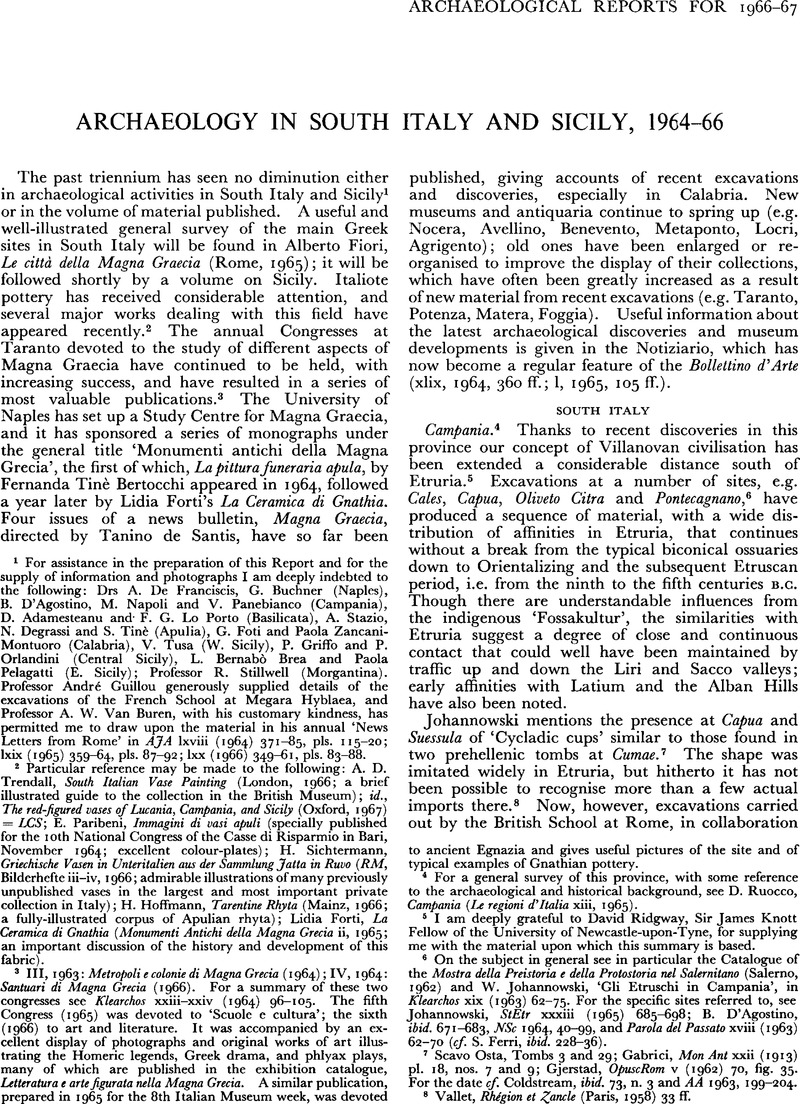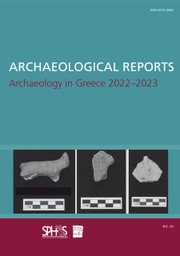No CrossRef data available.
Article contents
Archaeology in South Italy and Sicily, 1964–66
Published online by Cambridge University Press: 03 October 2012
Abstract

- Type
- Brief Report
- Information
- Copyright
- Copyright © Authors, the Society for the Promotion of Hellenic Studies and the British School at Athens 1967
References
1 For assistance in the preparation of this Report and for the supply of information and photographs I am deeply indebted to the following: Drs A. De Franciscis, G. Buchner (Naples), B. D'Agostino, M. Napoli and V. Panebianco (Campania), D. Adamesteanu and F. G. Lo Porto (Basilicata), A. Stazio, N. Degrassi and S. Tinè (Apulia), G. Foti and Paola Zancani-Montuoro (Calabria), V. Tusa (W. Sicily), P. Griffo and P. Orlandini (Central Sicily), L. Bernabò Brea and Paola Pelagatti (E. Sicily); Professor R. Stillwell (Morgantina). Professor André Guillou generously supplied details of the excavations of the French School at Megara Hyblaea, and Professor A. W. Van Buren, with his customary kindness, has permitted me to draw upon the material in his annual ‘News Letters from Rome’ in AJA lxviii (1964) 371–85, pls. 115–20; lxix (1965) 359–64, pls. 87–92; lxx (1966) 349–61, pls. 83–88.Google Scholar
2 Particular reference may be made to the following: Trendall, A. D., South Italian Vase Painting (London, 1966; a brief illustrated guide to the collection in the British Museum); id.Google Scholar, The red-figured vases of Lucania, Campania, and Sicily (Oxford, 1967) = LCS; E. Paribeni, Immagini di vasi apuli (specially published for the 10th National Congress of the Casse di Risparmio in Bari, November 1964; excellent colour-plates); H. Sichtermann, Griechische Vasen in Unteritalien aus der Sammlung Jatta in Ruvo (RM, Bilderhefte iii-iv, 1966; admirable illustrations of many previously unpublished vases in the largest and most important private collection in Italy); H. Hoffmann, Tarentine Rhyta (Mainz, 1966; a fully-illustrated corpus of Apulian rhyta); Lidia Forti, La Ceramica di Gnathia (Monumenti Antichi della Magna Grecia ii, 1965; an important discussion of the history and development of this fabric).Google Scholar
3 III, 1963: Metropoli e colonie di Magna Grecia (1964)Google Scholar; IV, 1964: Santuari di Magna Grecia (1966)Google Scholar. For a summary of these two congresses see Klearchos xxiii–xxiv (1964) 96–105. The fifth Congress (1965) was devoted to ‘Scuole e cultura’; the sixth (1966) to art and literature. It was accompanied by an excellent display of photographs and original works of art illustrating the Homeric legends, Greek drama, and phlyax plays, many of which are published in the exhibition catalogue, Letteratura e arte figurata nella Magna Grecia. A similar publication, prepared in 1965 for the 8th Italian Museum week, was devoted to ancient Egnazia and gives useful pictures of the site and of typical examples of Gnathian pottery.Google Scholar
4 For a general survey of this province, with some reference to the archaeological and historical background, see Ruocco, D., Campania (Le regioni d'Italia xiii, 1965).Google Scholar
5 I am deeply grateful to David Ridgway, Sir James Knott Fellow of the University of Newcastle-upon-Tyne, for supplying me with the material upon which this summary is based.
6 On the subject in general see in particular the Catalogue of the Mostra della Preistoria e della Protostoria nel Salernitano (Salerno, 1962)Google Scholar and Johannowski, W., ‘Gli Etruschi in Campania’, in Klearchos xix (1963) 62–75Google Scholar. For the specific sites referred to, see Johannowski, , StEtr xxxiii (1965) 685–698; B. D'Agostino, ibid. 671–683Google Scholar, NSc 1964, 40–99Google Scholar, and Parola del Passato xviii (1963) 62–70 (cf. S. Ferri, ibid. 228–36).Google Scholar
7 Scavo Osta, Tombs 3 and 29; Gabrici, , Mon Ant xxii (1913) pl. 18Google Scholar, nos. 7 and 9; Gjerstad, , OpuscRom v (1962) 70Google Scholar, fig. 35. For the date cf. Coldstream, ibid. 73, n. 3 and AA 1963, 199–204.Google Scholar
8 Vallet, , Rhégion et Zancle (Paris, 1958) 33 ff.Google Scholar
9 NSc 1963, 166, fig. 59a; 175, fig. 64; 271, fig. 132a–b (FF 16–17); 192, fig. 76 (GG 16–17); NSc 1965, 93, fig. 27 (EE 14–15); 108, fig. 36 (FF 14–15); 231, fig. 118 (GG 14–15). See further D. Ridgway in StEtr. forthcoming. Chevron-skyphoi from another cemetery at Veii, Grotta Gramiccia (publication in preparation by A. P. Vianello), were noted by Müller-Karpe, H. in Zur Stadtwerdung Roms (RM, Suppl. vol. viii, 1962) 59.Google Scholar
10 By Close-Brooks, J., NSc 1965, 53–64 and in StEtr (forthcoming).Google Scholar
11 Expedition viii, 4 (Summer 1966) 12.Google Scholar
12 The Western Greeks (Oxford, 1948) 3–8; cf.Google ScholarBoardman, J., The Greeks Overseas (Penguin, 1964) 176 f.Google Scholar
13 Blakeway, A., BSA xxxiii (1932–1933) 170–208Google Scholar; id. JRS xxv (1935) 129–149Google Scholar; Buchner, G., Atti III° Conv. Magna Grecia 1963 (1964) 263–274Google Scholar; id. Atti VI° Cong. Inst. Scienze Preist. Protost. 1962 iii (1966) 7–11Google Scholar; Boardman, J., BSA lii (1957) 9 f., 24 f.Google Scholar; see also papers forthcoming by W. Johannowski and B. D'Agostino in Dialoghi d'Archeologia and by Ridgway, D. in Actes VIIe Cong. Inst. Sciences Prehist. Protohist., 1966.Google Scholar
14 The Lyre-player Group will be fully discussed by G. Buchner and J. Boardman in their article ‘Seals from Ischia and the Lyre-player Group’ to appear in Jdl.
15 Impressions of the same seal-stone occur on a votive terracotta plaque from Samos (AM lxi, 1941, pl. 11, 416 = Hampe, Frühgriechische Sagenbilder pl. 34, and p. 72, fig. 31).
16 Cf. Meligunis-Lipáara ii, pls. 111.2 and 125.4
17 Zancani-Montuoro, P., Stoop, M. W. and Schläger, H., ‘L'edificio quadrato’, in Atti Soc. Magna Grecia n.s. vi–vii (1965–1966) 23–195Google Scholar; see also Atti IV° Convegno Magna Grecia 1964, 202–211.Google Scholar
18 See Velia e i Focei in Occidente, a special double-number of La Parola del Passato (cviii-ix, 1966), especially pp. 191–226, where a detailed summary of the results of recent excavation at Velia is given. See also Langlotz, E., Die kulturelle und kunstlerische Hellenisierung der Küsten des Mittelmeers durch die Stadt Phokaia (1966).Google Scholar
19 Ebner, P., ILN 31 Aug. 1963, p. 306, fig. 4.Google Scholar
20 A general survey of this province will be found in Basilicata (Electa, Milan; 1965), which contains two important archaeological articles, ‘L'archeologia nel Potentino’ by F. Ranaldi (pp. 91–126) and ‘L'archeologia nel Materano’ by A. Stazio (pp. 127–160).Google Scholar
21 Among the more important vases re-discovered at Matera are several from the Pisticci-Amykos and Creusa-Dolon workshops (LCS, 697–9), an Apulian phlyax krater showing Helen of Troy accompanied by two phlyakes with torches (Phlyax Vases 2, no. 44, pl. 3c), and a large calyx-krater by the Darius Painter with a representation of Andromeda.
22 BdA 1 (1965) 5–37, figs. 1–44Google Scholar; Archäologische Forschungen in Lukanien II. Herakleïastudien (RM supp. vol. xi, 1967) 198–231, pls. 50–80. See also LCS 50–59, 692–3, pls. 25–27. Also published in Herakleïastudien are the vases found earlier at this site.Google Scholar
23 Le Arti 1940, 92–100.Google Scholar
24 For a preliminary study of the new excavations, see Adamesteanu, D. in Matera (Rassegna economica della Camera di Commercio) x, 1965.Google Scholar
25 NSc 1965 (Supplemento) 179–184.Google Scholar
26 Caulonia e Metaponto (1959) 23–58, especially 50 ff.Google Scholar
27 BdA xlix (1964) 360–1Google Scholar; Atti del IV° Convegno Magna Grecia, 127 ff., pls. 3–6.Google Scholar
28 Sestieri, , FA xiii (1958) no. 2342Google Scholar; Adamesteanu, , Atti Soc. Magna Grecia n.s. vi–vii (1965–1966) 199–208.Google Scholar
29 Adamesteanu, op. cit. 204, note 18.
30 BdA xlix (1964) 392, fig. 1Google Scholar; La Parola del Passato c (1965) 93; Atti del IV° Convegno Magna Grecia, 168–9 and 232 ff., pl. 13.Google Scholar
31 Letteratura e arte figurata, no. 16 (ill.)
32 I am deeply grateful to Mr Alastair Small for furnishing me with details of this excavation, which is now published in BSR xxxiv (1966) 134–150.Google Scholar
33 Mertens, J., Ordona—I. Rapport provisoire sur les travaux de la mission belge en 1962/63 et 1963/64 (Brussels, 1965). Vol. II appeared in 1967.Google Scholar
34 AR 1960–1961 40Google Scholar; AJA lxiii (1959) pls. 98–9, figs. 13–14.Google Scholar
35 II Museo Nazionale di Reggio di Calabria—Guide Breve by Foti, G. (1966).Google Scholar
36 Foti, G., Klearchos xxi–xxii (1964) 21–26Google Scholar; Atti del IV° Convegno Magna Grecia, 148–9, pls. 9–10.Google Scholar
37 Klearchos xxiii–iv (1964) 106 ff., fig. 2; Atti del IV° Convegno, pl. 8.Google Scholar
38 For the inscription see Stoop, and Pugliese Caratelli, , Atti Soc. Magna Grecia n.s. vi–vii (1965–1966) 10–17, pl. IV, and 209–214Google Scholar; Ferri, , Studi Class. e. Orient. xiv (1965) 319–20Google Scholar; Guarducci, , RendLinc xx (1965) 392–5. For the lettering etc. cf. Jeffery, Local Scripts of Archaic Greece 248 ff.Google Scholar
39 20.18: Bieber, Hist. Theater,2 37, fig. 125a; Brommer, , AA 1942, 65 ff., figs. 1–5Google Scholar; Bielefeld, , AA 1946–1947, 48–54. Cf. also the r.f. psykter by Oltos in the Norbert Schimmel coll. (Hoffmann no. 25, ill.).Google Scholar
40 AR 1963–1964 43–4Google Scholar; the Shuvalov Painter's oenochoe (l.c. fig. 15) is now published in greater detail by Orlandini, P. in Cronache di Archeologia e di Storia dell'Arte iii (1964) 20–24, pls. 5–7.Google Scholar
41 II Museo Civico di Agrigento (Palermo, 1964) by Griffo, P. and Zirretta, G. tells the story of this museum during the first hundred years of its existence and illustrates a number of the more important items in it.Google Scholar
42 E. De Miro, L'Antiquarium e la zona archeologica di Eraclea Minoa (Itinerari dei Musei d'Italia, no. 110; 1965); bibliography of the site on p. 23.
43 AR 1963–1964 44–5Google Scholar; Orlandini, , Arch. Class. xvii (1965) 133–140, pls. 47–63Google Scholar; RendLinc xx (1965) 457–460Google Scholar; AJA lxix (1965) 362, pl. 89.Google Scholar
44 AR 1963–1964 45Google Scholar; AJA lxix (1965) 363. pl. 89, 8–10Google Scholar; Orlandini, , Kokalos xii (1966) 8–35.Google Scholar
45 Cf. Kokalos vii (1961) 141 ff., pls. 15–16.Google Scholar
46 Cf. Brea, Bernabò, Museum xvii (1964) 114–126.Google Scholar
47 See Lazzarini, , Rosa, La and Cappellani, , ‘Dieci anni di esplorazioni archeologiche nel Siracusano’, in Archivio Stor. Siracusano xi (1965) 137–46Google Scholar, and for a fuller account, Brea, Bernabò, Kokalos xii (1966) 40–69, pls. 27–46.Google Scholar
48 AJA lxx (1966) 357, pls. 84, 9 and 85, 10–12.Google Scholar
49 For an account of the earlier excavations see MonAnt xlvii (1965) 203–340Google Scholar. These include an account of the first excavations (1899) by Orsi (203–287), those of 1927 by Dr M. T. Currò (288–98), those of 1958–9 by E. Militello (299–335), and those of 1961 by V. Piscione (335–40). See also AJA lxx (1966) 357–9, pls. 86–7.Google Scholar
50 Phillips, Kyle, Art Bulletin xlii (1960) 243–262CrossRefGoogle Scholar; Stillwell, , AJA lxxi (1967) 247.Google Scholar
51 See Villard, , ‘La Céramique polychrome de Megara Hyblaea’, in Kokalos x–xi (1964–1965) 603–8Google Scholar; AJA lxx (1966) 359, pl. 88, fig. 17.Google Scholar
52 Brea, Bernabò, BdA 1 (1965) 202–205.Google Scholar




